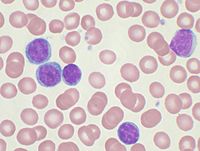
Photo from wikipedia
We retrospectively analyzed outcomes in patients with acute myeloid leukemia (AML) receiving reduced‐intensity conditioning (RIC) hematopoietic stem cell transplants (HCT) from a peripheral blood (PB) source. We identified 46 haploidentical… Click to show full abstract
We retrospectively analyzed outcomes in patients with acute myeloid leukemia (AML) receiving reduced‐intensity conditioning (RIC) hematopoietic stem cell transplants (HCT) from a peripheral blood (PB) source. We identified 46 haploidentical HCT (haplo), 59 matched unrelated donor HCT (MUD), and 40 matched related donor HCT (SIB) patients at a single institution. Haplo had improved overall survival (OS) when compared to MUD, HR 2.03 (P = 0.01) but not SIB, HR 1.17 (P = 0.61). There were no differences in relapse rates or treatment‐related mortality (TRM). Haplo had higher rates of acute graft‐versus‐host disease (GVHD) grade II–IV at day 180 than MUD (44% vs. 25%, P = 0.03) and SIB (44% vs. 13% P < 0.01). Rates of acute GVHD III–IV and chronic GVHD were similar among the groups. Haplo had slower engraftment rates compared to MUD with neutrophil engraftment at 87% vs. 93%, (P < 0.01) and platelet engraftment at 59% vs. 86%, (P < 0.01) at 28 days. Although patients receiving haplo had higher acute GVHD II–IV and slower engraftment, they did not have increased TRM. These data may suggest that patients receiving haplo have improved OS compared to MUD for AML patients receiving RIC transplants. This should be confirmed using a larger cohort.
Journal Title: Transplant International
Year Published: 2020
Link to full text (if available)
Share on Social Media: Sign Up to like & get
recommendations!